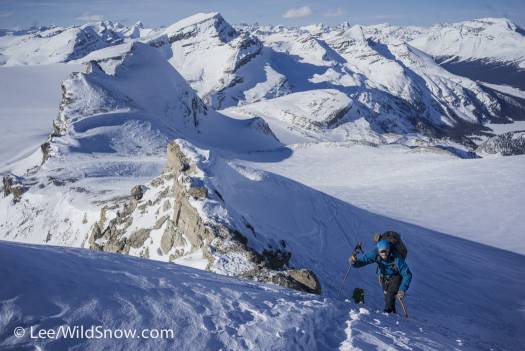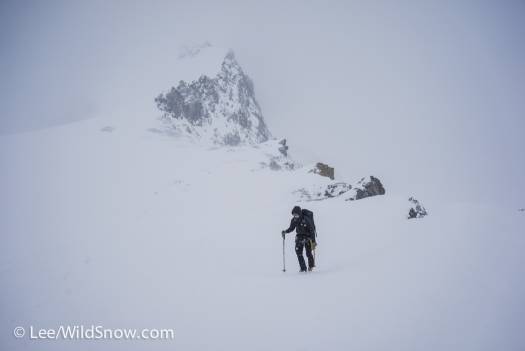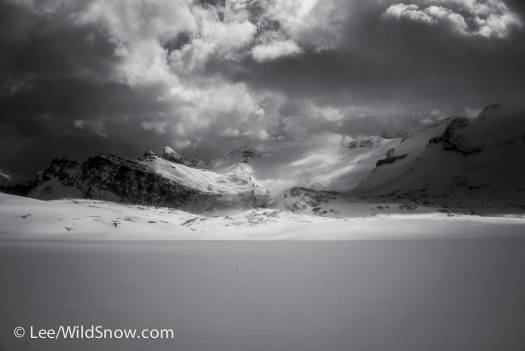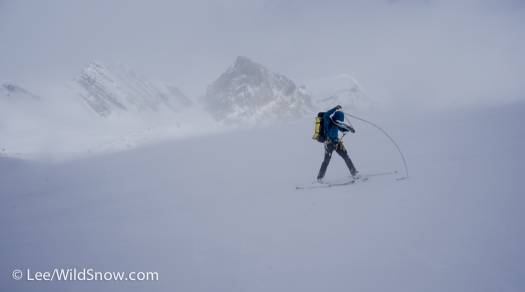March 31, 2015
Canada has had one of its warmest winters on record. So, waiting for Vince at the iron horse in the Calgary airport, I was a bit pessimistic about ski touring The Great White North. I had left Colorado a week earlier in search of BC pow, only to find out the real trouble with planning March trips in November. Now, on my way to the Canadian Rockies, Colorado was having what by all accounts was one of the best ski weeks of the winter.
For the past few years I have made an annual pilgrimage to the Rockies to go on what has usually turned out to be a somewhat suspect adventure with my friend Cody. This year we also had Vince with us after, while out for a ski two weeks before the trip, I floated the idea of a hut trip on the Wapta Ice Fields by him, and he immediately replied, “Yea, I’ll come!”
After finding Vince, Cody drove us up to Canmore for the night (he happens to live there). The next morning we got what I have come to call the “Colorado alpine start,” and finally started skinning across Bow Lake around 1 pm. We were heading up to the Wapta via the Bow Hut, the most accessible entry to the area, for a week of touring, mountaineering, and turns. The last time I had been on Bow Lake was also with Cody, in a -30F ice fog. We tent camped that trip, which was dumb since there are great huts nearby.
I was grateful for our warm weather this time around, despite a palpable uncertainty about the structural integrity of the lake’s edge in what felt like May conditions. One of the most remarkable things about the Wapta is that it is both big glaciated terrain high up on the spine of the Canadian Rockies, and also entirely accessible from an awesome hut system run by the Alpine Club of Canada. Hats off to the ACC for this!
My relationship with the Wapta began in 2010 working as a glaciologist. I was in college and I skied across the Wapta and Peyto Glacier, one of the Wapta’s few remaining outflows, with ice-penetrating radar, collecting data on ice thickness for the Dartmouth College glaciology lab. The Wapta icefields, straddling Banff and Yoho National Parks, in their entirety cover about 30 square miles of the Canadian Rockies. The mountains are not large or technical, but can none-the-less only be described as grand, rising in icy form out of a Pleistocene environment.
The drainage to west flows out the Yoho Valley in BC. There is still a lot of ice here. The westerly storms prefer this side of the ice divide, and looking down the Yoho you feel a bit like you might as well be in Antarctica. The Bow Glacier comprises the southern drainage of the Wapta. It once flowed down towards Bow Lake, but now clings to the high basin of the ice fields, a road to nowhere, with cliffs and mangled moraines below. To the north, ice flows down from the Wapta into a small tongue above Peyto Lake and Bow Summit, a popular area for day tours and backcountry turns in Banff National Park.
Historically, the Peyto has been the northern entrance and start to the well known ‘Wapta Traverse.’ This glacial tongue, provides passage from modernity to the ice ages of the past and already having lost more than 70% of its volume in the last half century, will be gone by roughly 2019. This trend is unfortunately typical for alpine glaciers to the east of the divide in the Canadian Rockies. This loss erodes, not only an environment that supports the watersheds of southern Alberta, but also an emotion and spirit that makes skiing here so special.
Skiing across Bow Lake, the trail winds through a small but narrow canyon before spitting you out above tree line. The Bow Hut is visible from here, but the path to it looks unlikely at best.
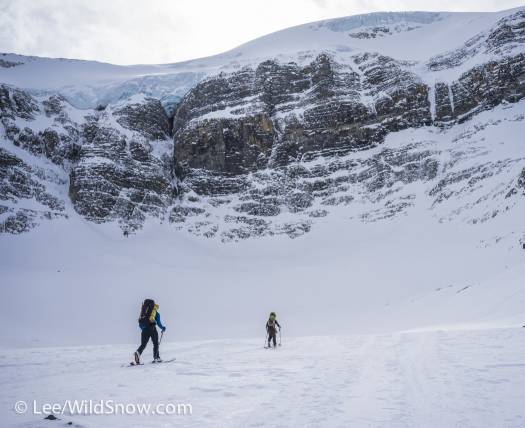
A large cirque at the head of the valley shows the flanks of the Vulture Glacier and British Columbia. A short gully around the corner leads easily to the Bow Hut.
Once at the hut we found a nice group of Swiss ski mountaineers, very kindly chopping wood, and a group of students from Appalachian State on an avalanche course (which by the way is awesome, what a rockin introduction to backcountry touring and avalanche education, and how freakin’ cool is it that a school in North Carolina give students that opportunity?). Vince was feeling figuratively a bit under the weather, but concerned that the entire ice field was supposed be literally under the weather the next day, we decided to capitalize on warm sunny conditions.
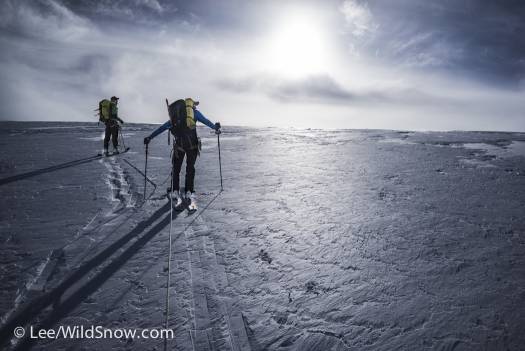
Ski touring high on the Wapta gives one a distinct feeling that the ice age still has a few final holdouts in the mountains of the north.
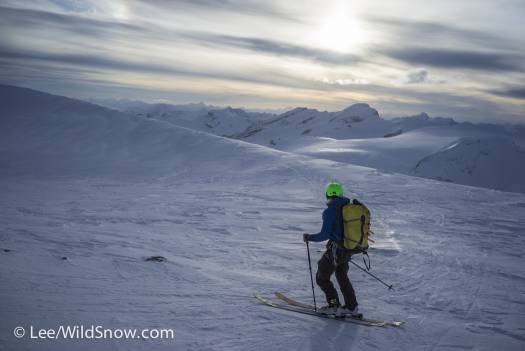
We took Lou Dawson’s ‘Wild Snow’ suggestion and skied up Mount Gordon for sunset. Though not very challenging, this has got to be one the most beautiful places I have ever skied.
The next couple days we wandered around in heavy clouds and light snow.
We found great turns in some very short but steep chutes below the Bow Hut, skied a nice slope below Mount St. Nicholas, and had a great tour circumambulating St. Nicholas, before packing up and heading down the Vulture Glacier to the Balfour Hut.
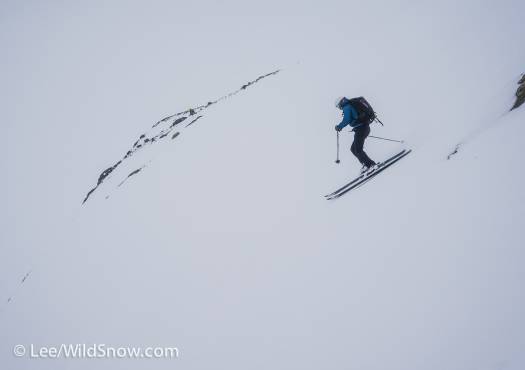
The flat light encouraged us to ski by feel, and discouraged any one of us from wanting to go first.
Bad winds and low visibility kept us inside our first day at Balfour, but improving weather gave us a chance at the best turns of the trip. I had never been into the Balfour Valley before and it is just awesome. With dwindling food supplies, we happily reminisced about Canmore’s ‘World of Burgers’ while settling into the hut, watching out the window as a group negotiated the crevasses on their way to the Balfour high col.
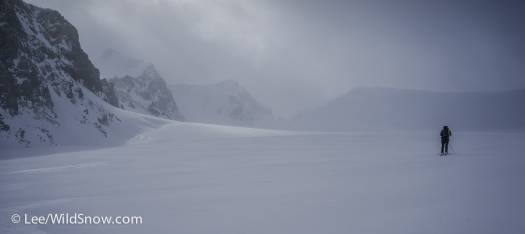
Heading towards the Olive Col, though nothing there is too gnarley, the ancient teeth of this place still shine white.
An aside, brought to you by Nick Vincent of Vail Colorado:
Vince’s Advice to the Wapta Newcomer:
Bring food. We ran out.
Bring a GPS, we had one and used it a lot.
Ski when the weather is good, no matter what (even if you have a cold).
Wear you seatbelt in Alberta. They take that sort of misbehavior very seriously in Canada (I got a $115 ticket…granted in Canadian dollars, but still….as a passenger!).
Get it while it’s good.
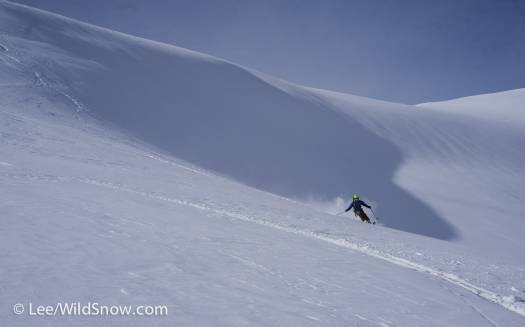
Skiing from the Balfour, the snow was nice, we found a good pitch and pretty long run, but most spectacular was the looming presence of Mount Balfour above us and Mount Gordon and Mount Olive across the valley.
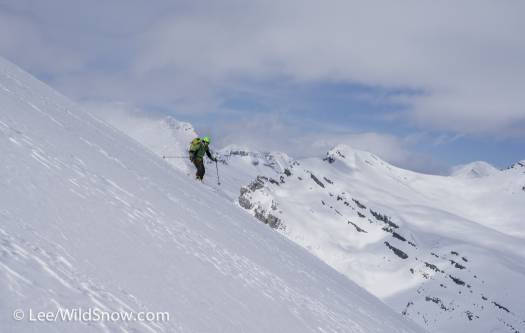
We found exceptionally good skiing on the Diablaret Glacier, lapping the southern bowl with ear-to-ear grins on our faces.
That night the wind picked up and the clouds descended. Just as the weather began to deteriorate, Cody started telling us about the poutine at La Belle in Canmore.
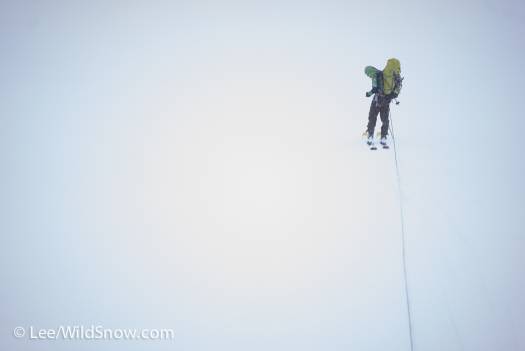
After flying by instrument back up the Vulture Glacier we opted for French fries and gravy instead of a final night at the Peyto Hut–if you go to La Belle, get the ‘Ian.’
The ACC is planning to build a new hut off of the Yoho Glacier as part of the Wapta system. This new hut would help connect the central Wapta to the Presidential Range and Stanley Mitchell Hut, expanding the already stellar access in the area. While the western side will likely be a remnant cryosphere hold out, the magic of the Wapta may not be around forever. While this might seem like a sobering thought, this ephemeral nature so rarely attached to the mountains gives me a greater appreciation for my experience there. The gravitas lent by a landscape in flux beckons the skier to explore, participate, and wonder in the mountains.
No one dimension of the Wapta rivals what you might find elsewhere, but I can’t help feeling that in totality, the experience there really is one of a kind. Huts, easy mountaineering, big glaciers, a vast and beautiful landscape that is only just small enough to still move across quickly, and a sprinkling of nice turns, make this a ski touring dream.
(WildSnow.com Guest Blogger, Alex Lee, lives in Leadville, Colorado in the winter and Denali, Alaska in the summer. He is currently working towards a Ph.D. in the ethics of conservation at the University of Colorado. He works part-time as a naturalist in Alaska and as a ski guide and photographer in the Colorado Rockies. Like his pictures? Check out more at his website, MountainDinosaur.com.
Nick Vicent resides in the Vail valley where he shakes cocktails at The Rose in Edwards, Colorado, guides part-time for Paragon Guides, and spends some time at Alpine Quest Sports behind the counter. Nick, on occasion, considers getting a real job some day but…lets go skiing.)
Dr. Alex Lee lives in Anchorage, Alaska. Alex is a professor at Alaska Pacific University, teaching philosophy and environmental studies. He also works as a sometimes guide, naturalist, writer, and photographer.

